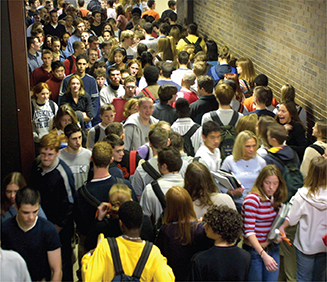Kinetic Theory of Gases
The kinetic theory explains the general properties of a gas.  The constant motion of particles in a gas allows a gas to fill a container of any shape or size. Think about air in a tire. The walls of the tire keep the air contained. What if there is a hole in the tire? Because the particles in the air are in constant motion, some of the particles would travel to the hole and move out of the tire. The kinetic theory as applied to gases has three main points.
The constant motion of particles in a gas allows a gas to fill a container of any shape or size. Think about air in a tire. The walls of the tire keep the air contained. What if there is a hole in the tire? Because the particles in the air are in constant motion, some of the particles would travel to the hole and move out of the tire. The kinetic theory as applied to gases has three main points.
Particles in a gas are in constant, random motion.
The motion of one particle is unaffected by the motion of other particles unless the particles collide.
Forces of attraction among particles in a gas can be ignored under ordinary conditions.

Describe the motion of particles in a gas.
Explaining the Behavior of Liquids
The particles in liquids also have kinetic energy. So why does a liquid such as mercury have a definite volume at room temperature instead of expanding to fill its container? The average speed of a mercury atom is much slower than the average speed of a helium atom at the same temperature. A mercury atom has about 50 times the mass of a helium atom. This greater mass is only partly responsible for the slower speed. What other factor is responsible?
The particles in a liquid are more closely packed than the particles in a gas. Therefore, attractions between the particles in a liquid do affect the movement of the particles. A mercury atom in liquid mercury is like a student in the crowded hallway in Figure 8. The student's path may be blocked by students moving in the other direction. The student's ability to move is affected by interactions with other students.
In a liquid, there is a kind of tug of war between the constant motion of particles and the attractions among particles. This tug of war explains the general behavior of liquids.  A liquid takes the shape of its container because particles in a liquid can flow to new locations. The volume of a liquid is constant because forces of attraction keep the particles close together. Because forces of attraction limit the motion of particles in a liquid, the particles in a liquid cannot spread out and fill a container.
A liquid takes the shape of its container because particles in a liquid can flow to new locations. The volume of a liquid is constant because forces of attraction keep the particles close together. Because forces of attraction limit the motion of particles in a liquid, the particles in a liquid cannot spread out and fill a container.
Figure 8 Particles in a liquid behave like students moving through a crowded hallway.







